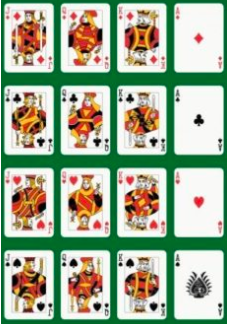Batch 3 - Class 235 - Uncut Spaghetti
(zoom)
Pre-Class Exercise
- (Dudeney 304) Arrange the Ace, King, Queen and Jack of all four suits in a 4x4 square so that none of the rows, columns of main diagonals have the same value or same suit occurring twice.

- Answer: Think about the value and color as independent solutions as in 1 and 2 below. Then combine the two.
.png)
Attendance Kabir, Vansh, Kushagra, Rhea, Rohan, Anshi, Angad, Shikher, Aashvi, Anishka, Arnav, Arjun, Aarkin, Rehaan, Advay, SidharthM, Muskaan
Class puzzles (Built on top of Class 122; powerpoint available)
Grids represent plates of spaghetti. You may start eating a spaghetti from any number, and then go to the smallest adjacent (4 sides) number, and so on. The objective is to not break the spaghetti, i.e. always have a place to go to an unvisited square. Is it always possible to do so on the given grids?
- Try with 4x4 grid - try different starting positions and let students guide through the path. Finally mark the cell as green or red depending on whether you could get the whole spaghetti without breaking it.
- As different combinations are tried, mark out where the path gets blocked (last square)
- Try with 6x6
- Try with 8x8 grid - do you see patterns of starting squares that succeed and those dont?
- Can you think about why these patterns are occuring?
- Can you predict the 10x10 pattern?
- What happens with an odd number plate, like 5x5 - what pattern do you see?
- Are there perfect patterns - Can you number a 4x4 grid in a form that all the squares are valid starting points?
- Get kids to think about the organizing principles - where should what kind of numbers go. Where are the most frequent trapdoors?
- Corners are the worst, then sides, then center - can you think why
- If that is the case, what kind of numbers should we place to avoid dark corners?
- Once you come to the center, you dont want to have to go back in a corner and not finish it. When do you need maximum options, beginning or end of game? Which positions give you maximum options - hence what kind of numbers should you place there?
- Can you do so with a 6x6 plate? 8x8?
- Is there a pattern to perfect plates?
- Can you create a perfectly imperfect plate - every spaghettum needs to break?
- Where should the trapdoors lie?
- How do you create a trapdoor?
- Whats the best you can do with a plate like this?
.png)
- Answer:
.png)
Homework:
(Dudeney 242) A tube inspector has been appointed, and he has to inspect the 17 lines connecting 12 stations of the tube regularly. In each phase, he wants to cover as little distance as possible to inspect the entire system. Each link is 1 mile long. Provide the shortest route that enables him to do so - he is free to start and end at any station.
.png)
- Answer: 19 miles - BADGDEFIFCBEHKLIHGJK. Can also be thought of as BADEFCBEHKLIHGJK - this leaves DG and FI links which can be traversed twice whenever we are at any of these 4 stations.
References:
https://ia902701.us.archive.org/4/items/AmusementsInMathematicspdf/AmusementsInMathematics.pdf - Dudeney